Nursing Case Study: Post-Operative Nursing Care for Hip Replacement
VerifiedAdded on 2021/05/27
|10
|2483
|259
Case Study
AI Summary
This nursing case study focuses on the post-operative care of Mrs. Grace Potter, a 67-year-old woman who underwent a total hip replacement (THR) due to rheumatoid arthritis. The case study emphasizes the importance of post-operative assessments, including vital signs, wound assessment, pain assessment, and neurovascular assessment. Key nursing priorities identified are managing post-operative wound infection and chronic pain. The essay details a comprehensive care plan, including interventions like glucose control, pharmacological interventions for rheumatoid arthritis, aseptic techniques for wound care, and pain management strategies such as NSAIDs and comfort measures. The student reflects on the critical thinking process, highlighting the significance of identifying risk factors and implementing evidence-based practices to promote patient recovery and reduce complications. The case study emphasizes the need for continuous assessment and patient-centered care in managing post-operative outcomes. The patient experienced post-operative pain and wound oozing which were addressed by the nursing care plan. The essay also mentions the importance of collaboration with other healthcare professionals such as dieticians and physiotherapists. The student concludes with a plan for future learning to improve pre-operative knowledge to prevent post-operative complications.
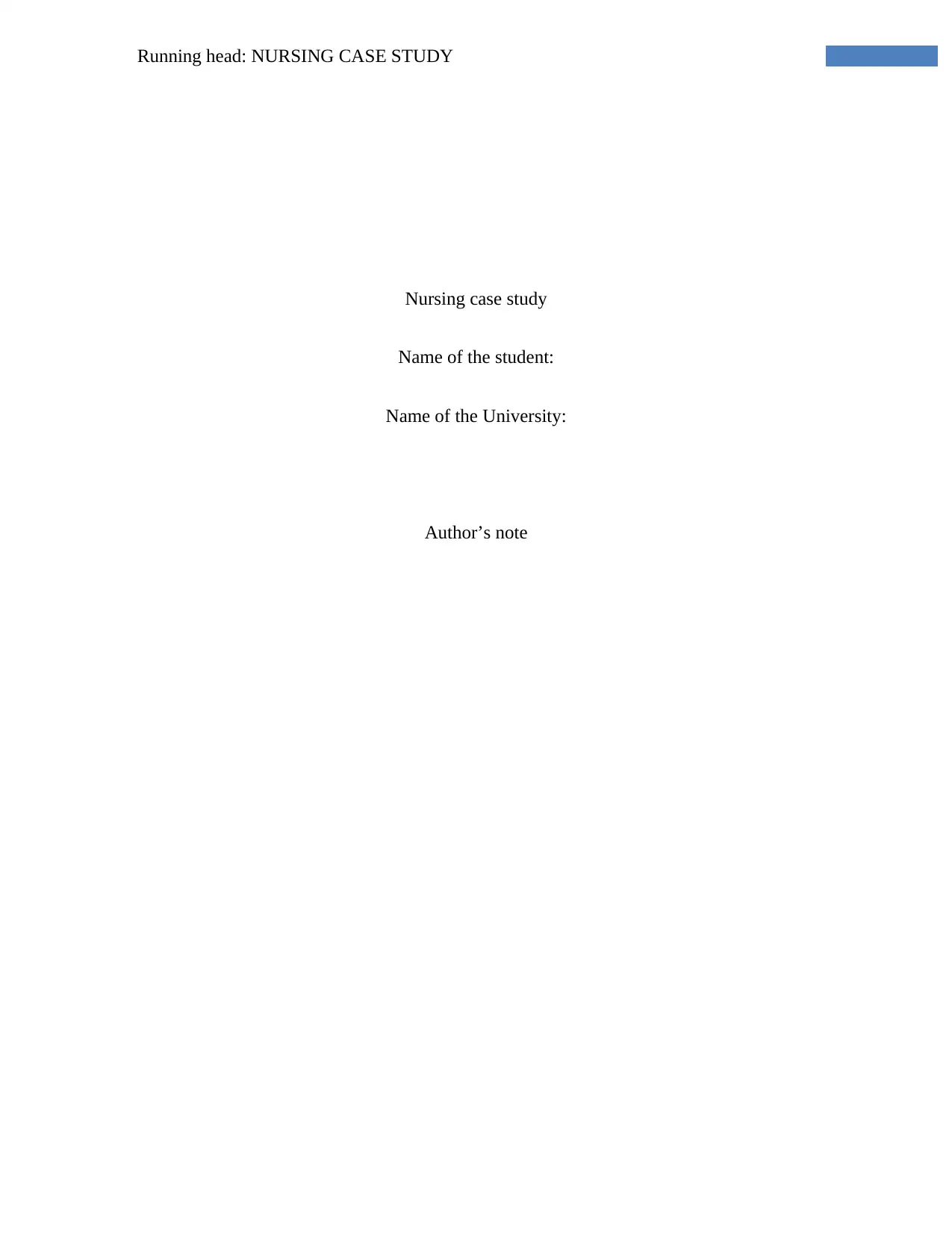
Running head: NURSING CASE STUDY
Nursing case study
Name of the student:
Name of the University:
Author’s note
Nursing case study
Name of the student:
Name of the University:
Author’s note
Paraphrase This Document
Need a fresh take? Get an instant paraphrase of this document with our AI Paraphraser
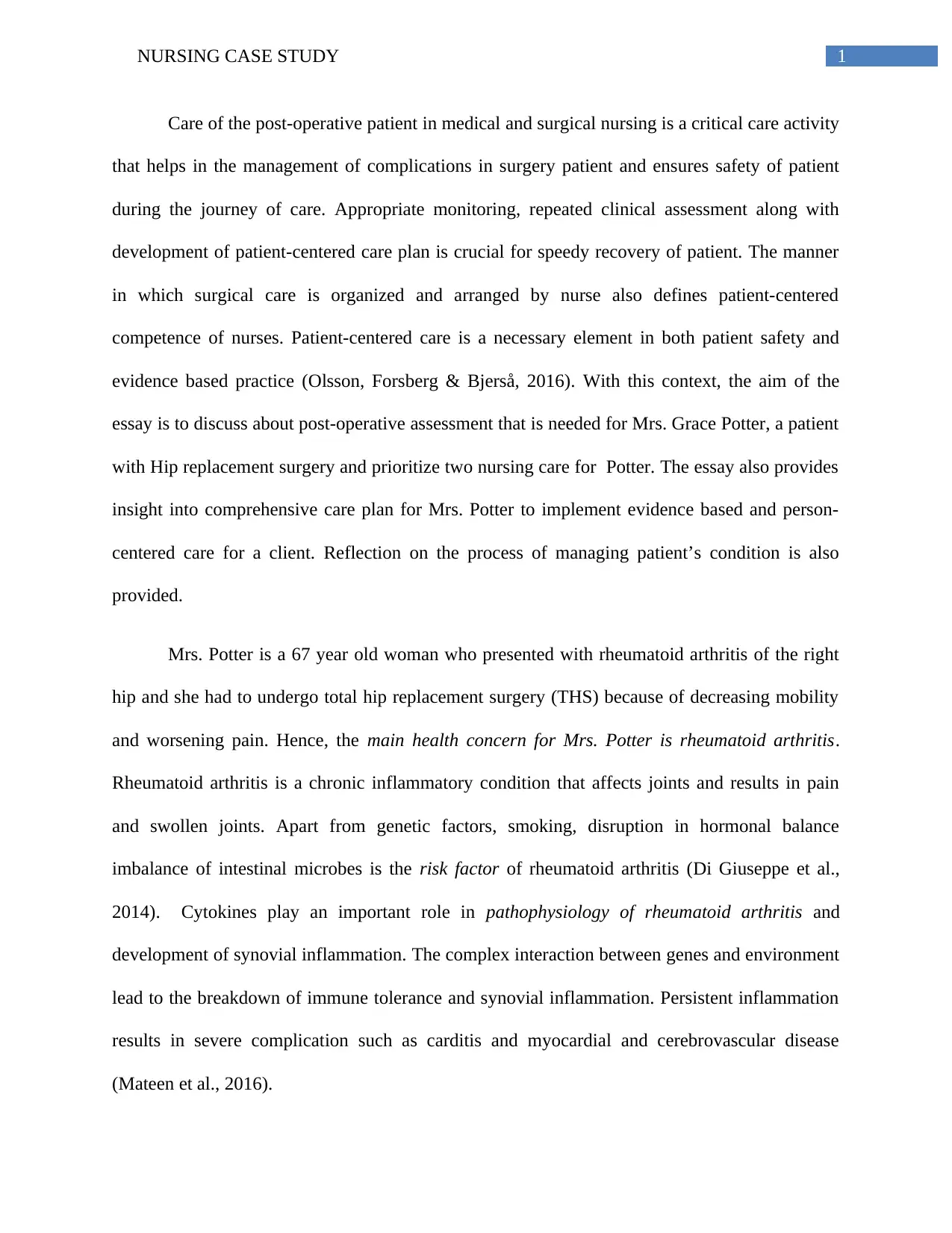
1NURSING CASE STUDY
Care of the post-operative patient in medical and surgical nursing is a critical care activity
that helps in the management of complications in surgery patient and ensures safety of patient
during the journey of care. Appropriate monitoring, repeated clinical assessment along with
development of patient-centered care plan is crucial for speedy recovery of patient. The manner
in which surgical care is organized and arranged by nurse also defines patient-centered
competence of nurses. Patient-centered care is a necessary element in both patient safety and
evidence based practice (Olsson, Forsberg & Bjerså, 2016). With this context, the aim of the
essay is to discuss about post-operative assessment that is needed for Mrs. Grace Potter, a patient
with Hip replacement surgery and prioritize two nursing care for Potter. The essay also provides
insight into comprehensive care plan for Mrs. Potter to implement evidence based and person-
centered care for a client. Reflection on the process of managing patient’s condition is also
provided.
Mrs. Potter is a 67 year old woman who presented with rheumatoid arthritis of the right
hip and she had to undergo total hip replacement surgery (THS) because of decreasing mobility
and worsening pain. Hence, the main health concern for Mrs. Potter is rheumatoid arthritis.
Rheumatoid arthritis is a chronic inflammatory condition that affects joints and results in pain
and swollen joints. Apart from genetic factors, smoking, disruption in hormonal balance
imbalance of intestinal microbes is the risk factor of rheumatoid arthritis (Di Giuseppe et al.,
2014). Cytokines play an important role in pathophysiology of rheumatoid arthritis and
development of synovial inflammation. The complex interaction between genes and environment
lead to the breakdown of immune tolerance and synovial inflammation. Persistent inflammation
results in severe complication such as carditis and myocardial and cerebrovascular disease
(Mateen et al., 2016).
Care of the post-operative patient in medical and surgical nursing is a critical care activity
that helps in the management of complications in surgery patient and ensures safety of patient
during the journey of care. Appropriate monitoring, repeated clinical assessment along with
development of patient-centered care plan is crucial for speedy recovery of patient. The manner
in which surgical care is organized and arranged by nurse also defines patient-centered
competence of nurses. Patient-centered care is a necessary element in both patient safety and
evidence based practice (Olsson, Forsberg & Bjerså, 2016). With this context, the aim of the
essay is to discuss about post-operative assessment that is needed for Mrs. Grace Potter, a patient
with Hip replacement surgery and prioritize two nursing care for Potter. The essay also provides
insight into comprehensive care plan for Mrs. Potter to implement evidence based and person-
centered care for a client. Reflection on the process of managing patient’s condition is also
provided.
Mrs. Potter is a 67 year old woman who presented with rheumatoid arthritis of the right
hip and she had to undergo total hip replacement surgery (THS) because of decreasing mobility
and worsening pain. Hence, the main health concern for Mrs. Potter is rheumatoid arthritis.
Rheumatoid arthritis is a chronic inflammatory condition that affects joints and results in pain
and swollen joints. Apart from genetic factors, smoking, disruption in hormonal balance
imbalance of intestinal microbes is the risk factor of rheumatoid arthritis (Di Giuseppe et al.,
2014). Cytokines play an important role in pathophysiology of rheumatoid arthritis and
development of synovial inflammation. The complex interaction between genes and environment
lead to the breakdown of immune tolerance and synovial inflammation. Persistent inflammation
results in severe complication such as carditis and myocardial and cerebrovascular disease
(Mateen et al., 2016).
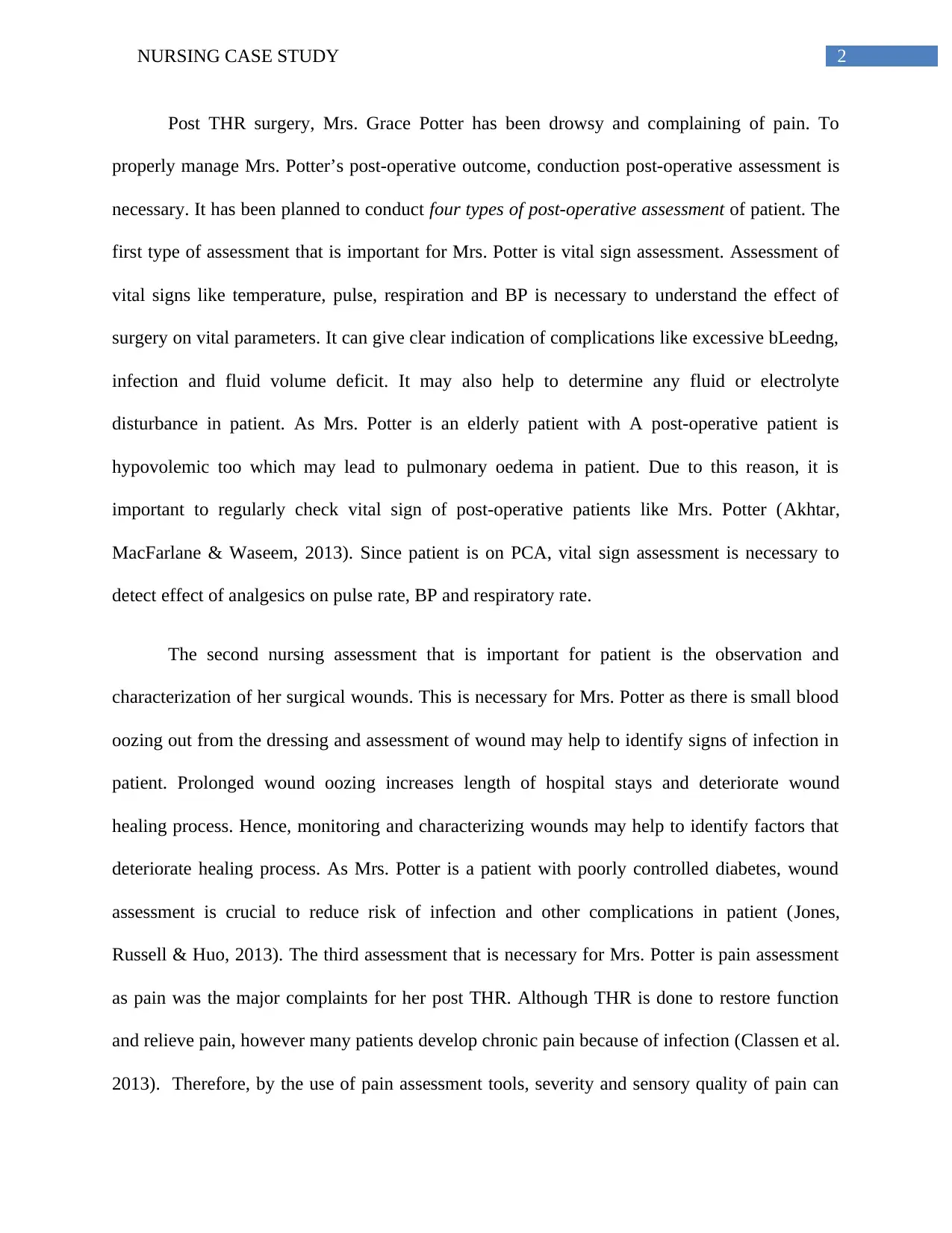
2NURSING CASE STUDY
Post THR surgery, Mrs. Grace Potter has been drowsy and complaining of pain. To
properly manage Mrs. Potter’s post-operative outcome, conduction post-operative assessment is
necessary. It has been planned to conduct four types of post-operative assessment of patient. The
first type of assessment that is important for Mrs. Potter is vital sign assessment. Assessment of
vital signs like temperature, pulse, respiration and BP is necessary to understand the effect of
surgery on vital parameters. It can give clear indication of complications like excessive bLeedng,
infection and fluid volume deficit. It may also help to determine any fluid or electrolyte
disturbance in patient. As Mrs. Potter is an elderly patient with A post-operative patient is
hypovolemic too which may lead to pulmonary oedema in patient. Due to this reason, it is
important to regularly check vital sign of post-operative patients like Mrs. Potter (Akhtar,
MacFarlane & Waseem, 2013). Since patient is on PCA, vital sign assessment is necessary to
detect effect of analgesics on pulse rate, BP and respiratory rate.
The second nursing assessment that is important for patient is the observation and
characterization of her surgical wounds. This is necessary for Mrs. Potter as there is small blood
oozing out from the dressing and assessment of wound may help to identify signs of infection in
patient. Prolonged wound oozing increases length of hospital stays and deteriorate wound
healing process. Hence, monitoring and characterizing wounds may help to identify factors that
deteriorate healing process. As Mrs. Potter is a patient with poorly controlled diabetes, wound
assessment is crucial to reduce risk of infection and other complications in patient (Jones,
Russell & Huo, 2013). The third assessment that is necessary for Mrs. Potter is pain assessment
as pain was the major complaints for her post THR. Although THR is done to restore function
and relieve pain, however many patients develop chronic pain because of infection (Classen et al.
2013). Therefore, by the use of pain assessment tools, severity and sensory quality of pain can
Post THR surgery, Mrs. Grace Potter has been drowsy and complaining of pain. To
properly manage Mrs. Potter’s post-operative outcome, conduction post-operative assessment is
necessary. It has been planned to conduct four types of post-operative assessment of patient. The
first type of assessment that is important for Mrs. Potter is vital sign assessment. Assessment of
vital signs like temperature, pulse, respiration and BP is necessary to understand the effect of
surgery on vital parameters. It can give clear indication of complications like excessive bLeedng,
infection and fluid volume deficit. It may also help to determine any fluid or electrolyte
disturbance in patient. As Mrs. Potter is an elderly patient with A post-operative patient is
hypovolemic too which may lead to pulmonary oedema in patient. Due to this reason, it is
important to regularly check vital sign of post-operative patients like Mrs. Potter (Akhtar,
MacFarlane & Waseem, 2013). Since patient is on PCA, vital sign assessment is necessary to
detect effect of analgesics on pulse rate, BP and respiratory rate.
The second nursing assessment that is important for patient is the observation and
characterization of her surgical wounds. This is necessary for Mrs. Potter as there is small blood
oozing out from the dressing and assessment of wound may help to identify signs of infection in
patient. Prolonged wound oozing increases length of hospital stays and deteriorate wound
healing process. Hence, monitoring and characterizing wounds may help to identify factors that
deteriorate healing process. As Mrs. Potter is a patient with poorly controlled diabetes, wound
assessment is crucial to reduce risk of infection and other complications in patient (Jones,
Russell & Huo, 2013). The third assessment that is necessary for Mrs. Potter is pain assessment
as pain was the major complaints for her post THR. Although THR is done to restore function
and relieve pain, however many patients develop chronic pain because of infection (Classen et al.
2013). Therefore, by the use of pain assessment tools, severity and sensory quality of pain can
⊘ This is a preview!⊘
Do you want full access?
Subscribe today to unlock all pages.

Trusted by 1+ million students worldwide
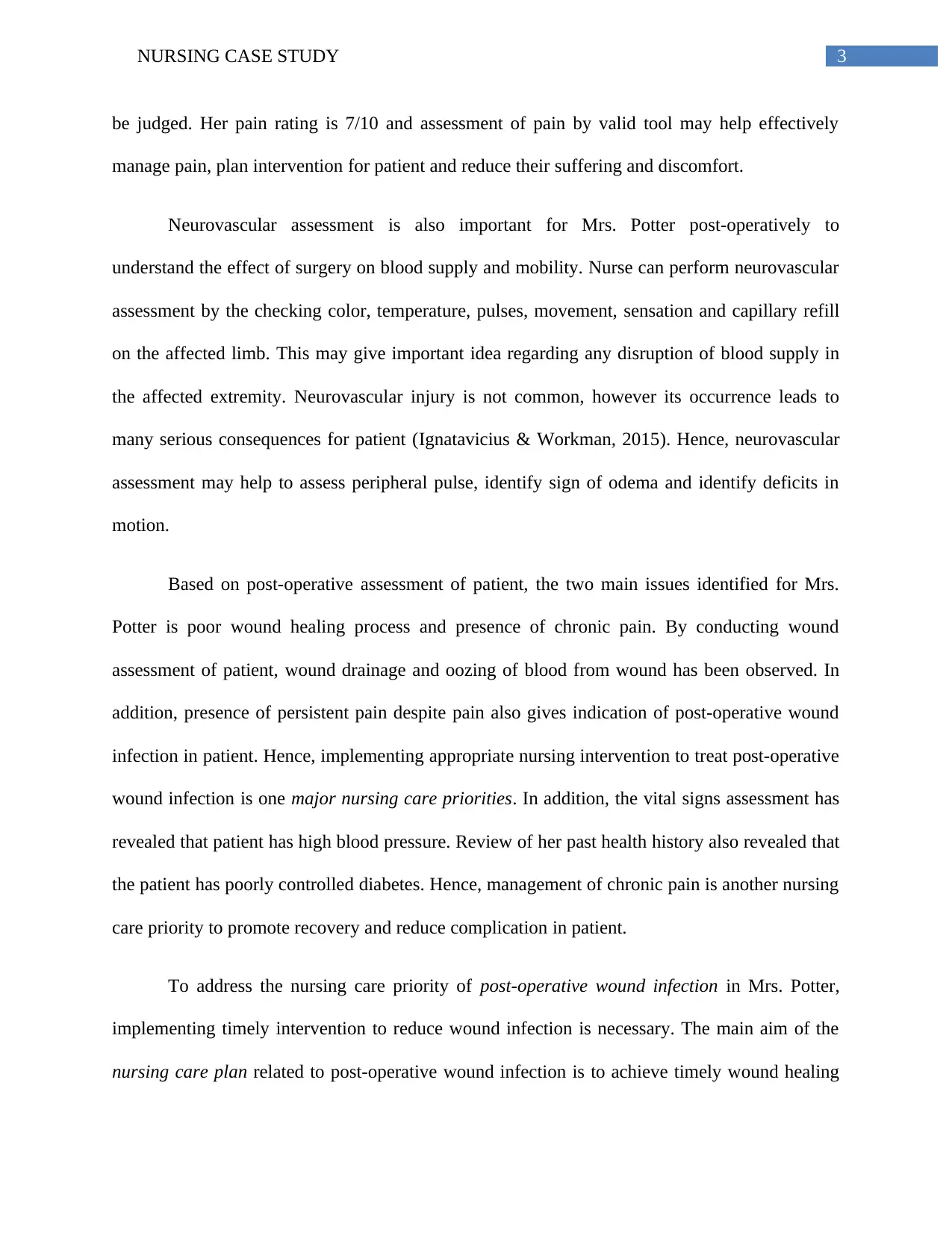
3NURSING CASE STUDY
be judged. Her pain rating is 7/10 and assessment of pain by valid tool may help effectively
manage pain, plan intervention for patient and reduce their suffering and discomfort.
Neurovascular assessment is also important for Mrs. Potter post-operatively to
understand the effect of surgery on blood supply and mobility. Nurse can perform neurovascular
assessment by the checking color, temperature, pulses, movement, sensation and capillary refill
on the affected limb. This may give important idea regarding any disruption of blood supply in
the affected extremity. Neurovascular injury is not common, however its occurrence leads to
many serious consequences for patient (Ignatavicius & Workman, 2015). Hence, neurovascular
assessment may help to assess peripheral pulse, identify sign of odema and identify deficits in
motion.
Based on post-operative assessment of patient, the two main issues identified for Mrs.
Potter is poor wound healing process and presence of chronic pain. By conducting wound
assessment of patient, wound drainage and oozing of blood from wound has been observed. In
addition, presence of persistent pain despite pain also gives indication of post-operative wound
infection in patient. Hence, implementing appropriate nursing intervention to treat post-operative
wound infection is one major nursing care priorities. In addition, the vital signs assessment has
revealed that patient has high blood pressure. Review of her past health history also revealed that
the patient has poorly controlled diabetes. Hence, management of chronic pain is another nursing
care priority to promote recovery and reduce complication in patient.
To address the nursing care priority of post-operative wound infection in Mrs. Potter,
implementing timely intervention to reduce wound infection is necessary. The main aim of the
nursing care plan related to post-operative wound infection is to achieve timely wound healing
be judged. Her pain rating is 7/10 and assessment of pain by valid tool may help effectively
manage pain, plan intervention for patient and reduce their suffering and discomfort.
Neurovascular assessment is also important for Mrs. Potter post-operatively to
understand the effect of surgery on blood supply and mobility. Nurse can perform neurovascular
assessment by the checking color, temperature, pulses, movement, sensation and capillary refill
on the affected limb. This may give important idea regarding any disruption of blood supply in
the affected extremity. Neurovascular injury is not common, however its occurrence leads to
many serious consequences for patient (Ignatavicius & Workman, 2015). Hence, neurovascular
assessment may help to assess peripheral pulse, identify sign of odema and identify deficits in
motion.
Based on post-operative assessment of patient, the two main issues identified for Mrs.
Potter is poor wound healing process and presence of chronic pain. By conducting wound
assessment of patient, wound drainage and oozing of blood from wound has been observed. In
addition, presence of persistent pain despite pain also gives indication of post-operative wound
infection in patient. Hence, implementing appropriate nursing intervention to treat post-operative
wound infection is one major nursing care priorities. In addition, the vital signs assessment has
revealed that patient has high blood pressure. Review of her past health history also revealed that
the patient has poorly controlled diabetes. Hence, management of chronic pain is another nursing
care priority to promote recovery and reduce complication in patient.
To address the nursing care priority of post-operative wound infection in Mrs. Potter,
implementing timely intervention to reduce wound infection is necessary. The main aim of the
nursing care plan related to post-operative wound infection is to achieve timely wound healing
Paraphrase This Document
Need a fresh take? Get an instant paraphrase of this document with our AI Paraphraser

4NURSING CASE STUDY
and make the surgical site free from purulent drainage. Surgical site infection after THS has
adverse impact on patient. As Mrs. Potter had increased drainage output evidenced by oozing of
blood from the wound, it is an indication of superficial infection. Prolonged wound drainage can
elevate risk for deept infection following THS (Triantafyllopoulos et al., 2015). Hence, prompt
action is necessary to manage infection in client. The first strategy to reduce infection is to
eliminate those factors that can deteriorate the condition of patient. Uncontrolled diabetes and
rheumatoid arthritis are independent risk factor of wound infection in THS. Patients with
diabetes are more susceptible to wound infection due to development of post-operative
hyperglycemia. Hyperglycemia increase susceptibility of monocyte to apoptosis and impaired
neutrophil function (Johnson et al., 2013). As Mrs. Potter is diabetic, aggressive glucose control
is necessary to reduce wound infection. The care plan is to determine blood glucose level of Mrs.
Potter and start sub-cutaneous insulin therapy for patient. Evidence suggest that implementation
of post-operative insulin protocol can decrease the rate of infection. Hyperglycemia is a common
link between factors contributing to infection and implementation of insulin protocol helps in the
management of infection (Gallagher et al., 2017).
Rheumatoid arthritis and smoking is also an independent risk factor of wound infection in
THS. Rheumatoid arthritis is an inflammatory disease and presence of local and systemic
corticosteroids increase risk of wound infection. Hence, after consultation with multi-
professional, pharmacological intervention can be implemented in patient to reduce risk.
Methotrexate drug can be provided to Mrs. Potter to treat rheumatoid arthritis and reduce risk of
infection (Johnson et al., 2013). Other approach that is planned to promote infection in patients
include use of assceptic technique during dressing to prevent any form of contamination and
maintain patency of drainage to prevent accumulation of blood in the surgical site. Furthermore,
and make the surgical site free from purulent drainage. Surgical site infection after THS has
adverse impact on patient. As Mrs. Potter had increased drainage output evidenced by oozing of
blood from the wound, it is an indication of superficial infection. Prolonged wound drainage can
elevate risk for deept infection following THS (Triantafyllopoulos et al., 2015). Hence, prompt
action is necessary to manage infection in client. The first strategy to reduce infection is to
eliminate those factors that can deteriorate the condition of patient. Uncontrolled diabetes and
rheumatoid arthritis are independent risk factor of wound infection in THS. Patients with
diabetes are more susceptible to wound infection due to development of post-operative
hyperglycemia. Hyperglycemia increase susceptibility of monocyte to apoptosis and impaired
neutrophil function (Johnson et al., 2013). As Mrs. Potter is diabetic, aggressive glucose control
is necessary to reduce wound infection. The care plan is to determine blood glucose level of Mrs.
Potter and start sub-cutaneous insulin therapy for patient. Evidence suggest that implementation
of post-operative insulin protocol can decrease the rate of infection. Hyperglycemia is a common
link between factors contributing to infection and implementation of insulin protocol helps in the
management of infection (Gallagher et al., 2017).
Rheumatoid arthritis and smoking is also an independent risk factor of wound infection in
THS. Rheumatoid arthritis is an inflammatory disease and presence of local and systemic
corticosteroids increase risk of wound infection. Hence, after consultation with multi-
professional, pharmacological intervention can be implemented in patient to reduce risk.
Methotrexate drug can be provided to Mrs. Potter to treat rheumatoid arthritis and reduce risk of
infection (Johnson et al., 2013). Other approach that is planned to promote infection in patients
include use of assceptic technique during dressing to prevent any form of contamination and
maintain patency of drainage to prevent accumulation of blood in the surgical site. Furthermore,
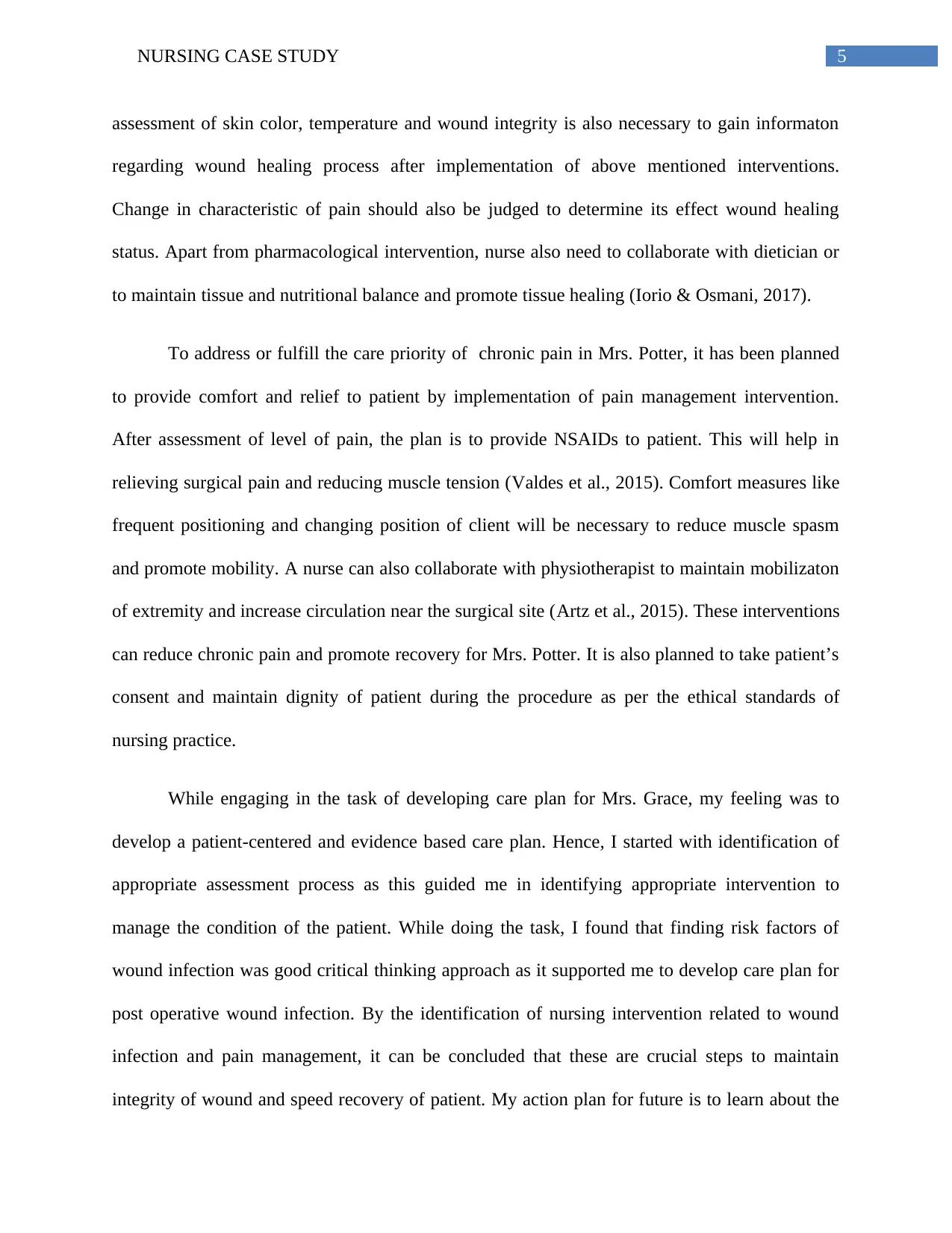
5NURSING CASE STUDY
assessment of skin color, temperature and wound integrity is also necessary to gain informaton
regarding wound healing process after implementation of above mentioned interventions.
Change in characteristic of pain should also be judged to determine its effect wound healing
status. Apart from pharmacological intervention, nurse also need to collaborate with dietician or
to maintain tissue and nutritional balance and promote tissue healing (Iorio & Osmani, 2017).
To address or fulfill the care priority of chronic pain in Mrs. Potter, it has been planned
to provide comfort and relief to patient by implementation of pain management intervention.
After assessment of level of pain, the plan is to provide NSAIDs to patient. This will help in
relieving surgical pain and reducing muscle tension (Valdes et al., 2015). Comfort measures like
frequent positioning and changing position of client will be necessary to reduce muscle spasm
and promote mobility. A nurse can also collaborate with physiotherapist to maintain mobilizaton
of extremity and increase circulation near the surgical site (Artz et al., 2015). These interventions
can reduce chronic pain and promote recovery for Mrs. Potter. It is also planned to take patient’s
consent and maintain dignity of patient during the procedure as per the ethical standards of
nursing practice.
While engaging in the task of developing care plan for Mrs. Grace, my feeling was to
develop a patient-centered and evidence based care plan. Hence, I started with identification of
appropriate assessment process as this guided me in identifying appropriate intervention to
manage the condition of the patient. While doing the task, I found that finding risk factors of
wound infection was good critical thinking approach as it supported me to develop care plan for
post operative wound infection. By the identification of nursing intervention related to wound
infection and pain management, it can be concluded that these are crucial steps to maintain
integrity of wound and speed recovery of patient. My action plan for future is to learn about the
assessment of skin color, temperature and wound integrity is also necessary to gain informaton
regarding wound healing process after implementation of above mentioned interventions.
Change in characteristic of pain should also be judged to determine its effect wound healing
status. Apart from pharmacological intervention, nurse also need to collaborate with dietician or
to maintain tissue and nutritional balance and promote tissue healing (Iorio & Osmani, 2017).
To address or fulfill the care priority of chronic pain in Mrs. Potter, it has been planned
to provide comfort and relief to patient by implementation of pain management intervention.
After assessment of level of pain, the plan is to provide NSAIDs to patient. This will help in
relieving surgical pain and reducing muscle tension (Valdes et al., 2015). Comfort measures like
frequent positioning and changing position of client will be necessary to reduce muscle spasm
and promote mobility. A nurse can also collaborate with physiotherapist to maintain mobilizaton
of extremity and increase circulation near the surgical site (Artz et al., 2015). These interventions
can reduce chronic pain and promote recovery for Mrs. Potter. It is also planned to take patient’s
consent and maintain dignity of patient during the procedure as per the ethical standards of
nursing practice.
While engaging in the task of developing care plan for Mrs. Grace, my feeling was to
develop a patient-centered and evidence based care plan. Hence, I started with identification of
appropriate assessment process as this guided me in identifying appropriate intervention to
manage the condition of the patient. While doing the task, I found that finding risk factors of
wound infection was good critical thinking approach as it supported me to develop care plan for
post operative wound infection. By the identification of nursing intervention related to wound
infection and pain management, it can be concluded that these are crucial steps to maintain
integrity of wound and speed recovery of patient. My action plan for future is to learn about the
⊘ This is a preview!⊘
Do you want full access?
Subscribe today to unlock all pages.

Trusted by 1+ million students worldwide
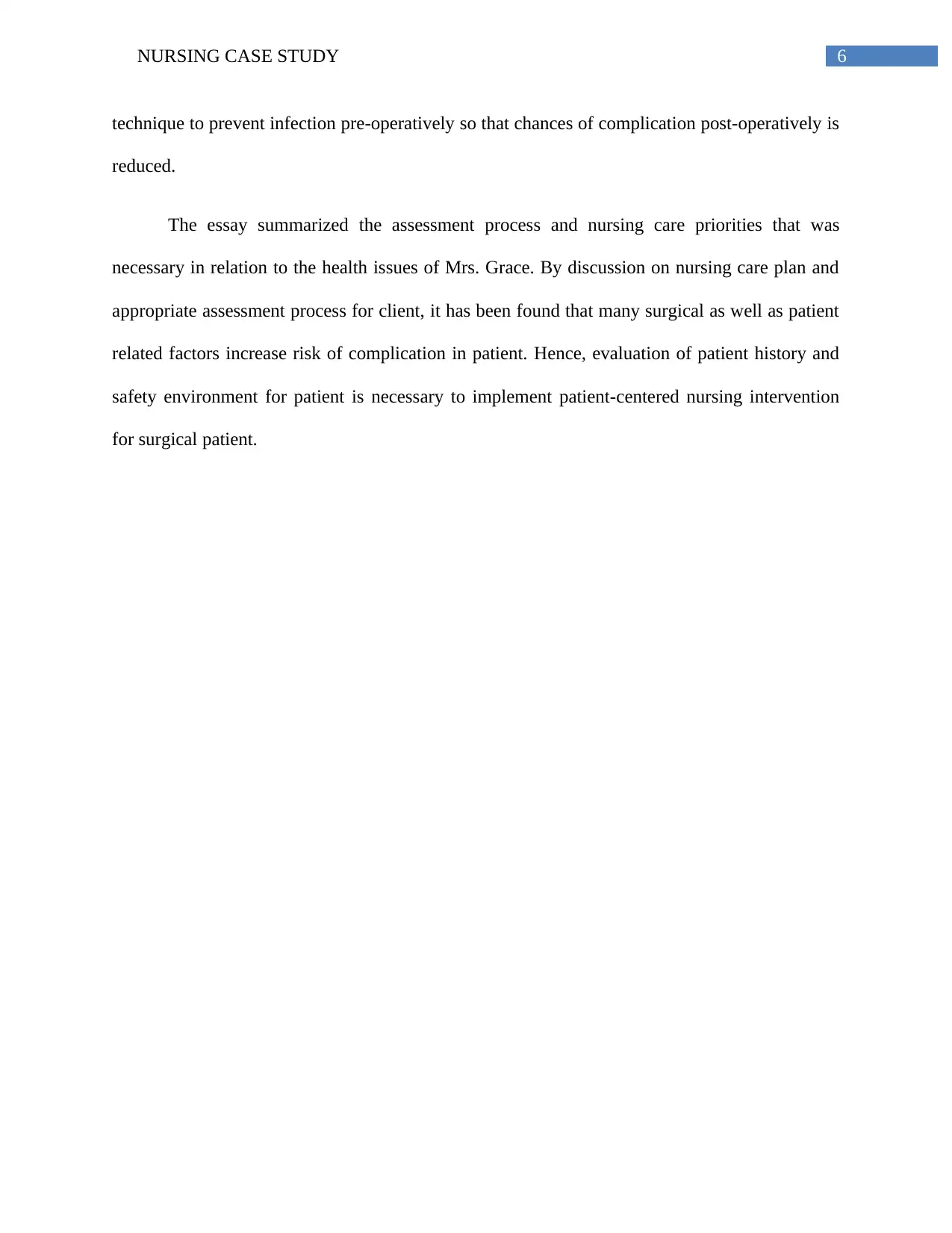
6NURSING CASE STUDY
technique to prevent infection pre-operatively so that chances of complication post-operatively is
reduced.
The essay summarized the assessment process and nursing care priorities that was
necessary in relation to the health issues of Mrs. Grace. By discussion on nursing care plan and
appropriate assessment process for client, it has been found that many surgical as well as patient
related factors increase risk of complication in patient. Hence, evaluation of patient history and
safety environment for patient is necessary to implement patient-centered nursing intervention
for surgical patient.
technique to prevent infection pre-operatively so that chances of complication post-operatively is
reduced.
The essay summarized the assessment process and nursing care priorities that was
necessary in relation to the health issues of Mrs. Grace. By discussion on nursing care plan and
appropriate assessment process for client, it has been found that many surgical as well as patient
related factors increase risk of complication in patient. Hence, evaluation of patient history and
safety environment for patient is necessary to implement patient-centered nursing intervention
for surgical patient.
Paraphrase This Document
Need a fresh take? Get an instant paraphrase of this document with our AI Paraphraser
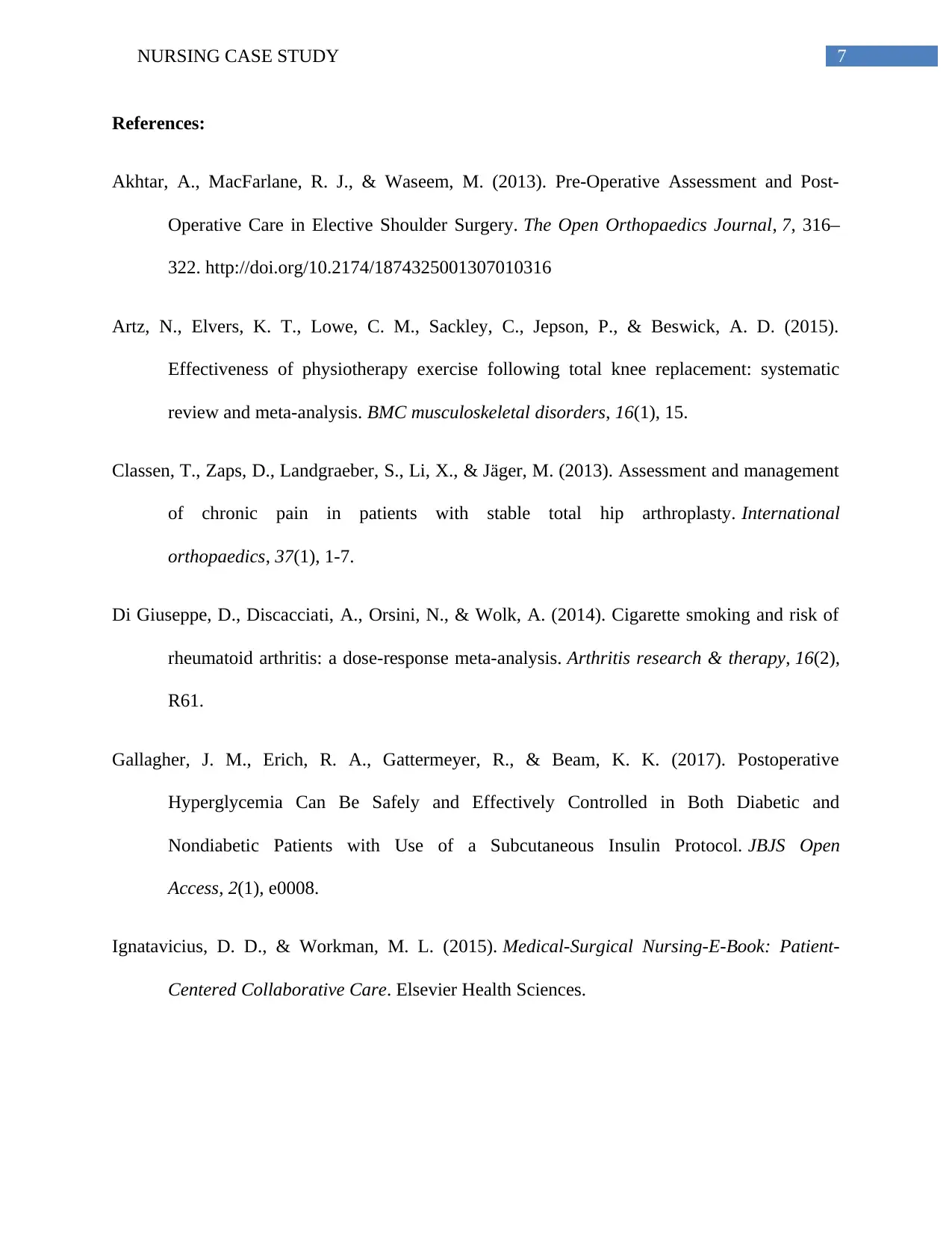
7NURSING CASE STUDY
References:
Akhtar, A., MacFarlane, R. J., & Waseem, M. (2013). Pre-Operative Assessment and Post-
Operative Care in Elective Shoulder Surgery. The Open Orthopaedics Journal, 7, 316–
322. http://doi.org/10.2174/1874325001307010316
Artz, N., Elvers, K. T., Lowe, C. M., Sackley, C., Jepson, P., & Beswick, A. D. (2015).
Effectiveness of physiotherapy exercise following total knee replacement: systematic
review and meta-analysis. BMC musculoskeletal disorders, 16(1), 15.
Classen, T., Zaps, D., Landgraeber, S., Li, X., & Jäger, M. (2013). Assessment and management
of chronic pain in patients with stable total hip arthroplasty. International
orthopaedics, 37(1), 1-7.
Di Giuseppe, D., Discacciati, A., Orsini, N., & Wolk, A. (2014). Cigarette smoking and risk of
rheumatoid arthritis: a dose-response meta-analysis. Arthritis research & therapy, 16(2),
R61.
Gallagher, J. M., Erich, R. A., Gattermeyer, R., & Beam, K. K. (2017). Postoperative
Hyperglycemia Can Be Safely and Effectively Controlled in Both Diabetic and
Nondiabetic Patients with Use of a Subcutaneous Insulin Protocol. JBJS Open
Access, 2(1), e0008.
Ignatavicius, D. D., & Workman, M. L. (2015). Medical-Surgical Nursing-E-Book: Patient-
Centered Collaborative Care. Elsevier Health Sciences.
References:
Akhtar, A., MacFarlane, R. J., & Waseem, M. (2013). Pre-Operative Assessment and Post-
Operative Care in Elective Shoulder Surgery. The Open Orthopaedics Journal, 7, 316–
322. http://doi.org/10.2174/1874325001307010316
Artz, N., Elvers, K. T., Lowe, C. M., Sackley, C., Jepson, P., & Beswick, A. D. (2015).
Effectiveness of physiotherapy exercise following total knee replacement: systematic
review and meta-analysis. BMC musculoskeletal disorders, 16(1), 15.
Classen, T., Zaps, D., Landgraeber, S., Li, X., & Jäger, M. (2013). Assessment and management
of chronic pain in patients with stable total hip arthroplasty. International
orthopaedics, 37(1), 1-7.
Di Giuseppe, D., Discacciati, A., Orsini, N., & Wolk, A. (2014). Cigarette smoking and risk of
rheumatoid arthritis: a dose-response meta-analysis. Arthritis research & therapy, 16(2),
R61.
Gallagher, J. M., Erich, R. A., Gattermeyer, R., & Beam, K. K. (2017). Postoperative
Hyperglycemia Can Be Safely and Effectively Controlled in Both Diabetic and
Nondiabetic Patients with Use of a Subcutaneous Insulin Protocol. JBJS Open
Access, 2(1), e0008.
Ignatavicius, D. D., & Workman, M. L. (2015). Medical-Surgical Nursing-E-Book: Patient-
Centered Collaborative Care. Elsevier Health Sciences.
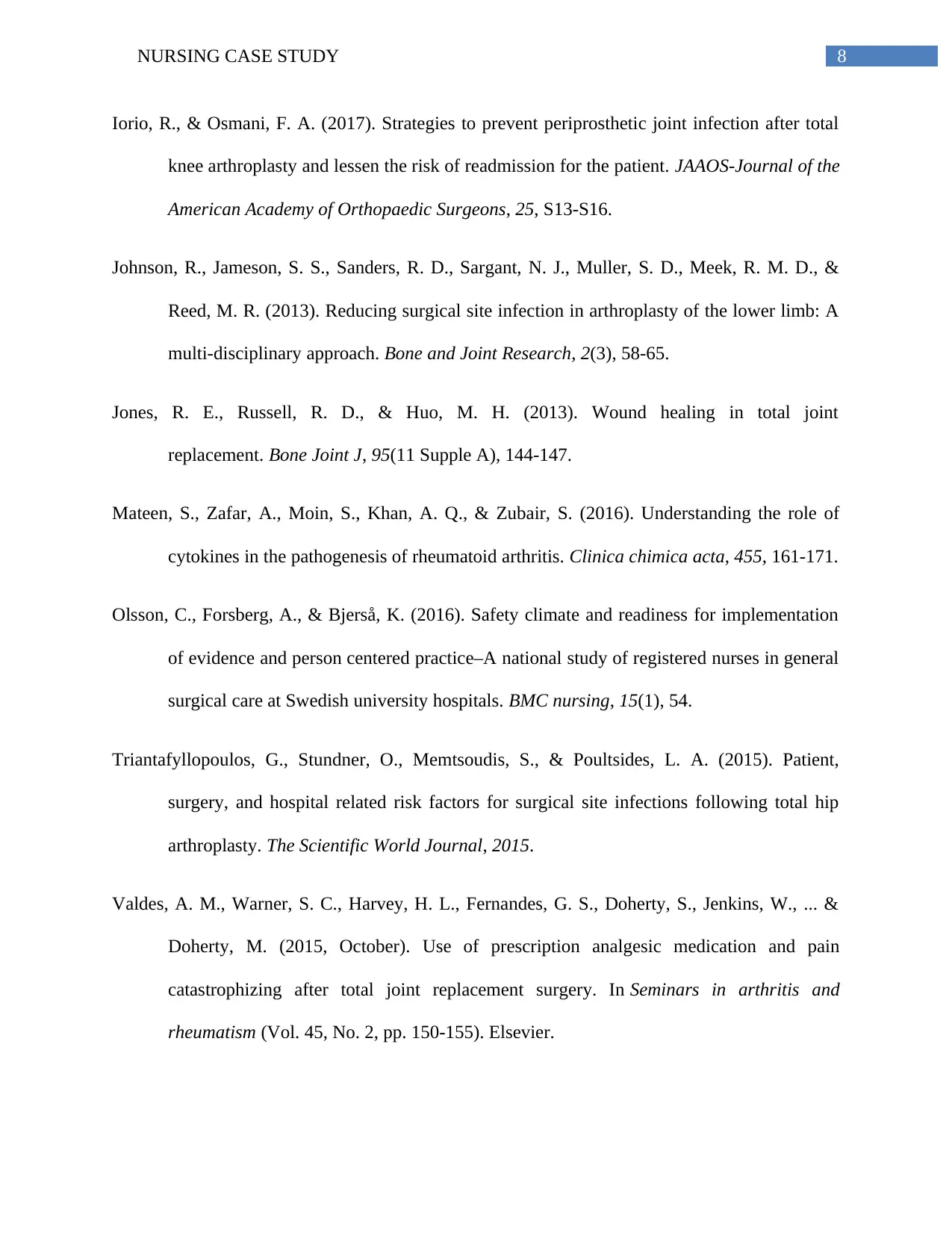
8NURSING CASE STUDY
Iorio, R., & Osmani, F. A. (2017). Strategies to prevent periprosthetic joint infection after total
knee arthroplasty and lessen the risk of readmission for the patient. JAAOS-Journal of the
American Academy of Orthopaedic Surgeons, 25, S13-S16.
Johnson, R., Jameson, S. S., Sanders, R. D., Sargant, N. J., Muller, S. D., Meek, R. M. D., &
Reed, M. R. (2013). Reducing surgical site infection in arthroplasty of the lower limb: A
multi-disciplinary approach. Bone and Joint Research, 2(3), 58-65.
Jones, R. E., Russell, R. D., & Huo, M. H. (2013). Wound healing in total joint
replacement. Bone Joint J, 95(11 Supple A), 144-147.
Mateen, S., Zafar, A., Moin, S., Khan, A. Q., & Zubair, S. (2016). Understanding the role of
cytokines in the pathogenesis of rheumatoid arthritis. Clinica chimica acta, 455, 161-171.
Olsson, C., Forsberg, A., & Bjerså, K. (2016). Safety climate and readiness for implementation
of evidence and person centered practice–A national study of registered nurses in general
surgical care at Swedish university hospitals. BMC nursing, 15(1), 54.
Triantafyllopoulos, G., Stundner, O., Memtsoudis, S., & Poultsides, L. A. (2015). Patient,
surgery, and hospital related risk factors for surgical site infections following total hip
arthroplasty. The Scientific World Journal, 2015.
Valdes, A. M., Warner, S. C., Harvey, H. L., Fernandes, G. S., Doherty, S., Jenkins, W., ... &
Doherty, M. (2015, October). Use of prescription analgesic medication and pain
catastrophizing after total joint replacement surgery. In Seminars in arthritis and
rheumatism (Vol. 45, No. 2, pp. 150-155). Elsevier.
Iorio, R., & Osmani, F. A. (2017). Strategies to prevent periprosthetic joint infection after total
knee arthroplasty and lessen the risk of readmission for the patient. JAAOS-Journal of the
American Academy of Orthopaedic Surgeons, 25, S13-S16.
Johnson, R., Jameson, S. S., Sanders, R. D., Sargant, N. J., Muller, S. D., Meek, R. M. D., &
Reed, M. R. (2013). Reducing surgical site infection in arthroplasty of the lower limb: A
multi-disciplinary approach. Bone and Joint Research, 2(3), 58-65.
Jones, R. E., Russell, R. D., & Huo, M. H. (2013). Wound healing in total joint
replacement. Bone Joint J, 95(11 Supple A), 144-147.
Mateen, S., Zafar, A., Moin, S., Khan, A. Q., & Zubair, S. (2016). Understanding the role of
cytokines in the pathogenesis of rheumatoid arthritis. Clinica chimica acta, 455, 161-171.
Olsson, C., Forsberg, A., & Bjerså, K. (2016). Safety climate and readiness for implementation
of evidence and person centered practice–A national study of registered nurses in general
surgical care at Swedish university hospitals. BMC nursing, 15(1), 54.
Triantafyllopoulos, G., Stundner, O., Memtsoudis, S., & Poultsides, L. A. (2015). Patient,
surgery, and hospital related risk factors for surgical site infections following total hip
arthroplasty. The Scientific World Journal, 2015.
Valdes, A. M., Warner, S. C., Harvey, H. L., Fernandes, G. S., Doherty, S., Jenkins, W., ... &
Doherty, M. (2015, October). Use of prescription analgesic medication and pain
catastrophizing after total joint replacement surgery. In Seminars in arthritis and
rheumatism (Vol. 45, No. 2, pp. 150-155). Elsevier.
⊘ This is a preview!⊘
Do you want full access?
Subscribe today to unlock all pages.

Trusted by 1+ million students worldwide

9NURSING CASE STUDY
1 out of 10
Related Documents
Your All-in-One AI-Powered Toolkit for Academic Success.
+13062052269
info@desklib.com
Available 24*7 on WhatsApp / Email
![[object Object]](/_next/static/media/star-bottom.7253800d.svg)
Unlock your academic potential
Copyright © 2020–2025 A2Z Services. All Rights Reserved. Developed and managed by ZUCOL.





